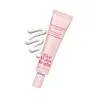What's inside
What's inside
 Key Ingredients
Key Ingredients

 Benefits
Benefits

 Concerns
Concerns

 Ingredients Side-by-side
Ingredients Side-by-side

Water
Skin ConditioningGlycerin
HumectantButylene Glycol
HumectantSqualane
EmollientDipentaerythrityl Tetrahydroxystearate/Tetraisostearate
Skin ConditioningBehenyl Alcohol
EmollientPvp
Emulsion StabilisingPentaerythrityl Tetraethylhexanoate
EmollientPEG-150
HumectantDimethicone
EmollientPentylene Glycol
Skin ConditioningBeeswax
Emulsion StabilisingDipentaerythrityl Tri-Polyhydroxystearate
EmollientPEG-60 Glyceryl Isostearate
Macadamia Ternifolia Seed Oil
EmollientGlyceryl Stearate
EmollientTrimethylsiloxysilicate
EmollientRetinol
Skin ConditioningRetinyl Palmitate
Skin ConditioningMilk Ferment
Skin ConditioningSoy Isoflavones
Skin ConditioningGlycine Max Seed Extract
Skin ConditioningCeramide Ng
Skin ConditioningSodium Tocopheryl Phosphate
AntioxidantDipropylene Glycol
HumectantPEG-40 Hydrogenated Castor Oil
EmulsifyingPPG-4-Ceteth-20
EmulsifyingSodium Ascorbate
AntioxidantAlcohol Denat.
AntimicrobialEthylhexylglycerin
Skin ConditioningCarbomer
Emulsion StabilisingXanthan Gum
EmulsifyingZea Mays Oil
EmulsifyingTocopherol
AntioxidantCaprylic/Capric Triglyceride
MaskingPolysorbate 80
EmulsifyingInulin Lauryl Carbamate
Emulsion StabilisingLecithin
EmollientSodium Hydroxide
BufferingPhenoxyethanol
PreservativeMethylparaben
PreservativeWater, Glycerin, Butylene Glycol, Squalane, Dipentaerythrityl Tetrahydroxystearate/Tetraisostearate, Behenyl Alcohol, Pvp, Pentaerythrityl Tetraethylhexanoate, PEG-150, Dimethicone, Pentylene Glycol, Beeswax, Dipentaerythrityl Tri-Polyhydroxystearate, PEG-60 Glyceryl Isostearate, Macadamia Ternifolia Seed Oil, Glyceryl Stearate, Trimethylsiloxysilicate, Retinol, Retinyl Palmitate, Milk Ferment, Soy Isoflavones, Glycine Max Seed Extract, Ceramide Ng, Sodium Tocopheryl Phosphate, Dipropylene Glycol, PEG-40 Hydrogenated Castor Oil, PPG-4-Ceteth-20, Sodium Ascorbate, Alcohol Denat., Ethylhexylglycerin, Carbomer, Xanthan Gum, Zea Mays Oil, Tocopherol, Caprylic/Capric Triglyceride, Polysorbate 80, Inulin Lauryl Carbamate, Lecithin, Sodium Hydroxide, Phenoxyethanol, Methylparaben
Water
Skin ConditioningCaprylic/Capric Triglyceride
MaskingPropanediol
SolventGlycerin
HumectantElaeis Guineensis Oil
EmollientButyrospermum Parkii Butter
Skin ConditioningMacadamia Ternifolia Seed Oil
Emollient1,2-Hexanediol
Skin ConditioningBetaine
HumectantElaeis Guineensis Kernel Oil
EmollientBehenyl Alcohol
EmollientTri-C14-15 Alkyl Citrate
EmollientCaprylic/Capric Glycerides
EmollientTromethamine
BufferingCarbomer
Emulsion StabilisingButylene Glycol
HumectantPalmitic Acid
EmollientDisodium EDTA
Niacinamide
SmoothingPolyglycerin-3
HumectantStearic Acid
CleansingGlycine Soja Seed Extract
Skin ConditioningLactobacillus/Soybean Ferment Extract
Skin ConditioningSaccharomyces/Potato Extract Ferment Filtrate
HumectantSodium Polyacrylate
AbsorbentSaccharomyces/Barley Seed Ferment Filtrate
HumectantOryza Sativa Bran Oil
EmollientSodium Hyaluronate
HumectantHibiscus Sabdariffa Flower Extract
Skin ConditioningSaccharomyces/Rice Ferment Filtrate
Skin ConditioningOryza Sativa Extract
AbsorbentWater, Caprylic/Capric Triglyceride, Propanediol, Glycerin, Elaeis Guineensis Oil, Butyrospermum Parkii Butter, Macadamia Ternifolia Seed Oil, 1,2-Hexanediol, Betaine, Elaeis Guineensis Kernel Oil, Behenyl Alcohol, Tri-C14-15 Alkyl Citrate, Caprylic/Capric Glycerides, Tromethamine, Carbomer, Butylene Glycol, Palmitic Acid, Disodium EDTA, Niacinamide, Polyglycerin-3, Stearic Acid, Glycine Soja Seed Extract, Lactobacillus/Soybean Ferment Extract, Saccharomyces/Potato Extract Ferment Filtrate, Sodium Polyacrylate, Saccharomyces/Barley Seed Ferment Filtrate, Oryza Sativa Bran Oil, Sodium Hyaluronate, Hibiscus Sabdariffa Flower Extract, Saccharomyces/Rice Ferment Filtrate, Oryza Sativa Extract
 Reviews
Reviews

Ingredients Explained
These ingredients are found in both products.
Ingredients higher up in an ingredient list are typically present in a larger amount.
Behenyl Alcohol is a type of fatty alcohol (these are different from the drying, solvent alcohols).
Fatty Alcohols have hydrating properties and are most often used as an emollient or to thicken a product. They are usually derived from natural fats and oils; behenyl alcohol is derived from the fats of vegetable oils.
Emollients help keep your skin soft and hydrated by creating a film that traps moisture in.
In 2000, Behenyl Alcohol was approved by the US as medicine to reduce the duration of cold sores.
Learn more about Behenyl AlcoholButylene Glycol (or BG) is used within cosmetic products for a few different reasons:
Overall, Butylene Glycol is a safe and well-rounded ingredient that works well with other ingredients.
Though this ingredient works well with most skin types, some people with sensitive skin may experience a reaction such as allergic rashes, closed comedones, or itchiness.
Learn more about Butylene GlycolThis ingredient is an emollient, solvent, and texture enhancer. It is considered a skin-softener by helping the skin prevent moisture loss.
It helps thicken a product's formula and makes it easier to spread by dissolving clumping compounds.
Caprylic Triglyceride is made by combining glycerin with coconut oil, forming a clear liquid.
While there is an assumption Caprylic Triglyceride can clog pores due to it being derived from coconut oil, there is no research supporting this.
Learn more about Caprylic/Capric TriglycerideCarbomer is a polymer of acrylic acid. Its main role is to create a gel consistency.
A high amount of carbomer can cause pilling or balling up of products. Don't worry, most products contain 1% or less of carbomer.
Glycerin is already naturally found in your skin. It helps moisturize and protect your skin.
A study from 2016 found glycerin to be more effective as a humectant than AHAs and hyaluronic acid.
As a humectant, it helps the skin stay hydrated by pulling moisture to your skin. The low molecular weight of glycerin allows it to pull moisture into the deeper layers of your skin.
Hydrated skin improves your skin barrier; Your skin barrier helps protect against irritants and bacteria.
Glycerin has also been found to have antimicrobial and antiviral properties. Due to these properties, glycerin is often used in wound and burn treatments.
In cosmetics, glycerin is usually derived from plants such as soybean or palm. However, it can also be sourced from animals, such as tallow or animal fat.
This ingredient is organic, colorless, odorless, and non-toxic.
Glycerin is the name for this ingredient in American English. British English uses Glycerol/Glycerine.
Learn more about GlycerinMacadamia Ternifolia Seed Oil is the fixed oil obtained from Macadamia nut.
Macadamia seed oil is rich in fatty acids, including oleic acid (45-75%), palmitoleic acid (7-33%), and palmitic acid (6-12%). They also contain various B vitamins, iron, and magnesium.
Palmitoleic acid has been shown to help soothe inflammation and promote wound healing. It is also naturally found in the fat of our skin.
Macadamia seed oil may not be malassezia folliculitis, or fungal-acne, safe.
Learn more about Macadamia Ternifolia Seed OilWater. It's the most common cosmetic ingredient of all. You'll usually see it at the top of ingredient lists, meaning that it makes up the largest part of the product.
So why is it so popular? Water most often acts as a solvent - this means that it helps dissolve other ingredients into the formulation.
You'll also recognize water as that liquid we all need to stay alive. If you see this, drink a glass of water. Stay hydrated!
Learn more about Water